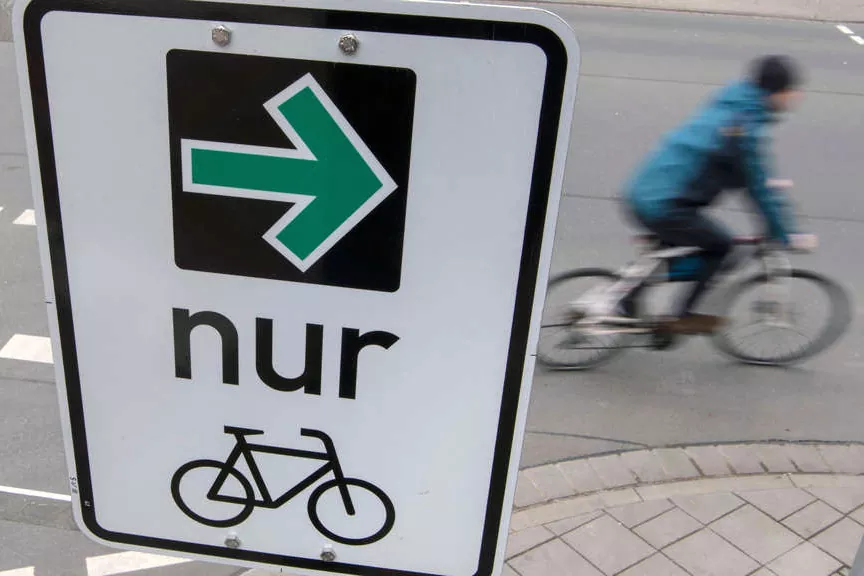New Austrian Road Traffic Code in review

On the 29th of April, minister for climate protection Leonore Gewessler presented the latest draft of the Austrian road traffic code which promises to contain important improvements for cyclists and pedestrians. It is currently under review until the 1st of June and will be put to a parliamentary vote after that. Some of its highlights include ‘right turns on red’, minimum overtaking requirements for cars, and legalising riding two abreast.
What’s new in the draft?
Below are some of the most important changes which will effect cycling. You can find the entire draft here, from which we have taken the quoted points. The draft is open to suggestions and improvements until the 1st of June in the online portal of the Austrian Government here.
- Clearly defined overtaking distances: in urban areas, motorised traffic must give cyclists at least 1.5m space when overtaking. Outside of urban areas the minimum legal overtaking distance is 2m. Up to 30 km/h however, this distance can be less as long as ‘a distance and speed is maintained which ensures the safety of the vehicle being overtaken’.
- Introduction of ‘right turn on red’: towns and cities now have the opportunity to allow cycle traffic to turn right through a red light, using an additional sign. Cyclists must first stop, as if at a stop sign and then give way to crossing pedestrians before making their turn. At T-Junctions, cycling straight on through a red light will be allowed. However, this will only be implemented in locations in
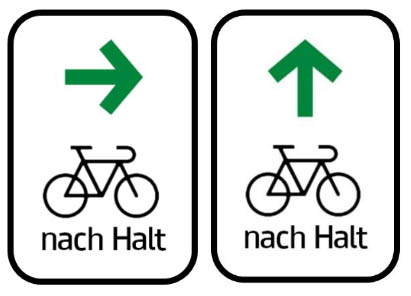 which ‘there is no reason to believe that the safety of cyclists and other traffic could in any way be put at risk’.
which ‘there is no reason to believe that the safety of cyclists and other traffic could in any way be put at risk’. - Bidirectional one way streets for cyclists will become the norm: in future, streets which are wider than 4m without parking spaces will be available by default for bidirectional cycling unless the local authority decides that it is not possible for reasons of safety.
- Riding two abreast legalised: in future, riding two abreast, for example next to a child, will be allowed. This is a big relief to parents and others accompanying vulnerable road users. All cyclists will be allowed to ride a normal bike next to another on a normal bike on all roads with a 30 km/h speed limit, except for roads with tram tracks and designated major routes. Another caveat to the rule is that it is only allowed if ‘no-one is endangered, the weight of traffic allows for it, and overtaking traffic isn’t impeded’.
- Faster E-Bikes allowed on regional cycle routes: S-Pedelecs (e-bikes with a top speed of 45 km/h and which must be fitted with a number plate) along with agricultural traffic will now be allowed on cycle paths and on mixed-use pedestrian and cycle paths outside of urban areas. They must all adhere to a maximum speed of 25 km/h when using these paths.
- Easier implementation of bike-priority streets: the German model of bike-priority streets is to be adopted (see picture), making
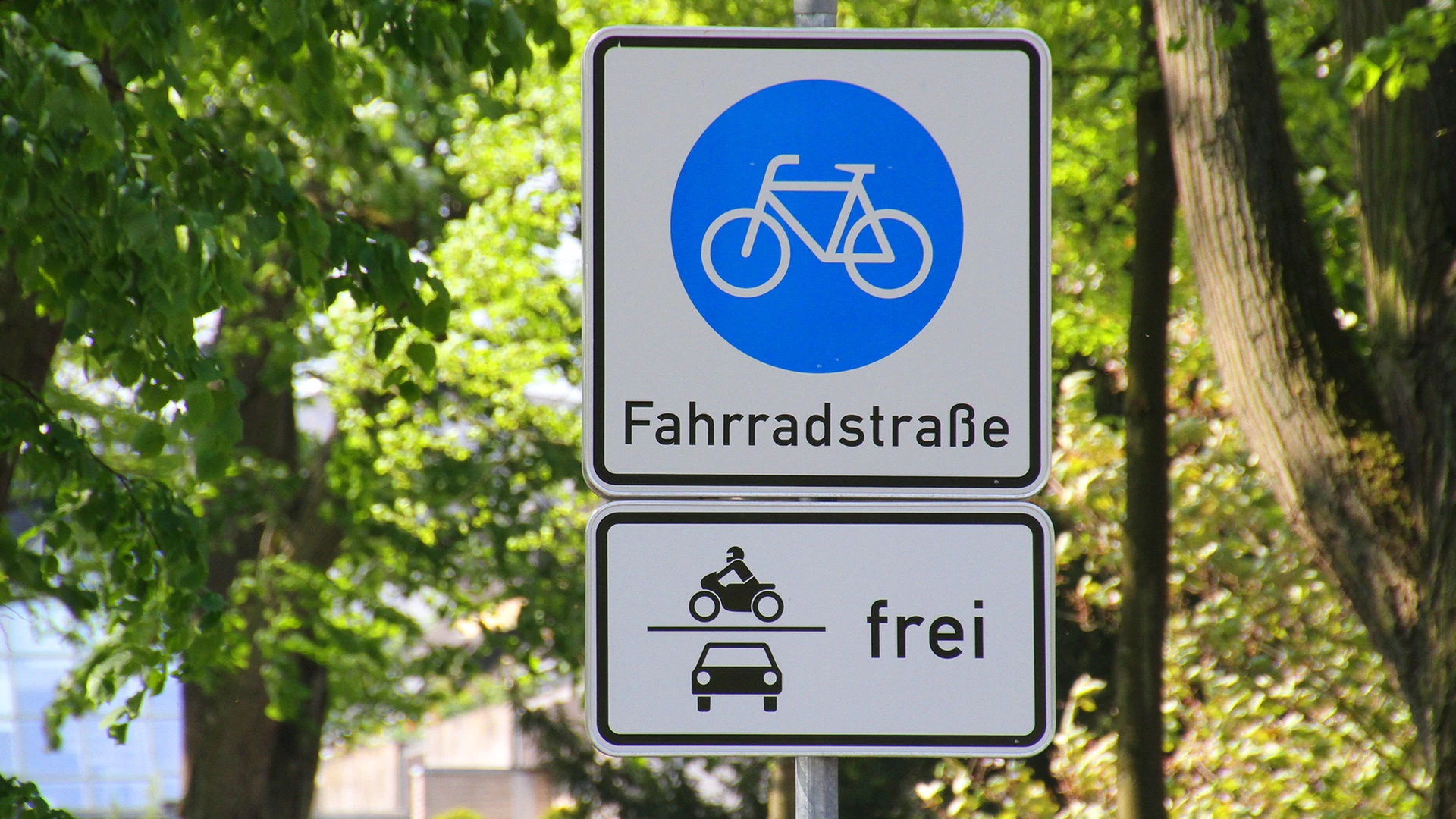 their implementation much more attractive to planners. This model allows for motorised through-traffic ‘for certain reasons or at certain times of day, depending on specific situational requirements and needs’.
their implementation much more attractive to planners. This model allows for motorised through-traffic ‘for certain reasons or at certain times of day, depending on specific situational requirements and needs’. - Junction crossing in a continuous group: groups of ten cyclists or more will now be allowed to continue crossing a junction even after the light has turned red. Some conditions apply however: ‘riders entering the junction must obey the applicable rights of way, the leading cyclists must make the end of the group clear to other road users through the use of hand signals and if needs be, get off of the bike in order to do so and the first and last riders of the group must wear reflective vests’.
- Improvements to bike crossings: the rule still applies that cyclists approaching bike crossings without traffic lights must reduce their speed to a maximum of 10 km/h, in order avoid ‘crossing directly in front of a vehicle in an unpredictable and unexpected way’, however this rule now only applies ‘when a motorised vehicle is in the direct vicinity of a junction’.
- Clarity regarding fines: if cyclists are missing one or more legally required pieces of equipment, such as a bell, lights or reflectors, one fine will be applied rather than multiple fines based on individual items.
- Bike parking in pedestrianised areas: currently, cyclists are only allowed to park their bikes in pedestrianised areas for the length of time for which they are active in the area, and during the hours in which the pedestrian zone is used by traffic. In future bike parking in these areas will be allowed 24/7.
From blue lights to cul-de-sacs.
The following improvements are also in the new road traffic code draft:
- Pedestrians will be prioritised at traffic lights. The green phase for pedestrians will be made longer, the red phase for motor traffic shorter.
- Motor vehicles will be explicitly prohibited from blocking or impinging on areas designated for foot and cycle traffic such as foot and bike paths.
- The Schulstraße, which was recently designated as a traffic-calmed zone will get its own new signage prohibiting motorised traffic during certain times and making the school only accessible on foot or by bicycle. This is made easier by the fact that universal signage will be introduced for this purpose.
- HGVs will be restricted to walking speed when turning right if there are pedestrians or cyclists in close proximity. More specifically: ‘if there is the possibility of cycle traffic travelling straight ahead, cycle traffic turning right from the travelled route, or the possibility of pedestrians in the immediate vicinity of the junction’.
- Driving or riding past the side of trams and busses from which passengers exit at stops will no longer be allowed. This will apply to cyclists as well as motor vehicles to increase the safety of pedestrians.
- The police force will be allowed to mount lights and sirens to bikes used in public service.
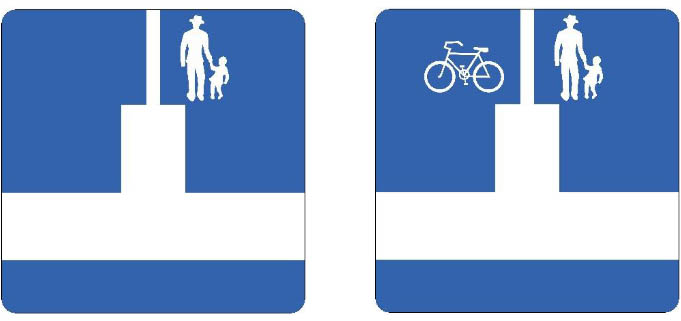
- New signage showing through-route access for pedestrians and cyclists will be mounted in cul-de-sacs. These signs will also indicate the distance and direction to the nearest electric charging station. The current directional signage for cycle routes will also be officially included in the traffic code.
- As per the current traffic code, pedestrians are, in general, still required to use a marked crossing (traffic lights, zebra crossing, pelican crossing) if they are no more than 25m away from one, however the new rules stipulate that this is no longer strictly necessary ‘if it is beyond doubt that the traffic conditions allow the street to be crossed safely and without disrupting or hindering traffic’.
- Pedestrians are now allowed to cross directly to a traffic island or public transport stop if the traffic is neither regulated by lights or manually by traffic officers.
- In order to improve visibility at junctions, the current no-parking zone will be increased from 5m to 8m from the apex of the junction, either by road markings or by physical installations.
You can read the extensive accompanying description to the new parliamentary draft here.
Studies show: ‘right turn on red’ is safe.
Many of the new rules being introduced demonstrate the need for political compromise, such as the restrictions to two abreast cycling, or the requirement for the first and last riders in a large group to wear reflective vests when crossing junctions as a group. Furthermore, experts were in favour of opening one way streets to bidirectional cycle traffic from a width of 3.5m instead of the planned 4m. In Belgium, for example, one way streets are open to opposite bike traffic from a width of 3m and in Switzerland streets are bidirectional by default unless local authorities decide otherwise for reasons of safety.
Austria is using the German model for the new ‘right turn on red’ laws, which we have already reported on here. In such cases, an additional sign with a green arrow shows traffic lights which, after stopping, are allowed to be ridden through as long as nobody is endangered or hindered. The German Federal Highway Research Institute (BASt) ran a pilot project to investigate the possibility of ‘right turn on red’ in 2019. The results were clear – the arrow for cyclists is safe and in general, other road users were neither hindered nor endangered by its implementation.
The German Federal Highway Research Institute came to the conclusion that a widespread implementation was safe and possible, indeed this proved to be the case even when cyclists didn’t come to a complete stop (source: ADFC).
The pilot project in Basel, Switzerland in 2013 showed that the likelihood of conflict between right-turning cyclists and pedestrians with right of way crossing the road was extremely small – less than 0.5%; nor was there a single accident caused by the over 1 million instances of cyclists turning right through a red light during the entire trial period (source: Mobilservice). Following this, Switzerland introduced ‘right turn on red’ nation-wide.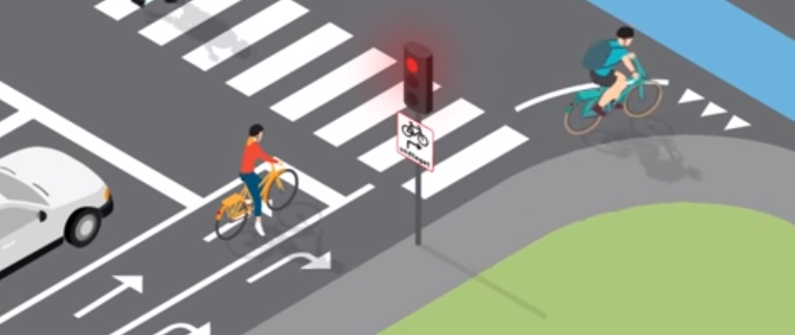
Belgium and France have also introduced similar laws after trial periods. In all of these countries, the situation is governed by the ‘right of way’ principle, without the need for the cyclists to come to a complete stop. The same applies in Denmark, as shown in the illustration.
Cycle Competence video from France.
As an example of the ubiquitous ‘right turn on red’ in Paris, the video below demonstrates two common situations, one of which is riding straight on at a t-junction.
Assessment by Radlobby Austria
Cycle Competence member Radlobby Austria gave their first assessment of the new road traffic code draft on the 29th of April, which we can publish here:
With the draft of the 2022 traffic regulations, Austria has finally made a start in catching up to its European neighbours in terms of mobility evolution and development. However, more investment and further legal improvements are needed, especially in regional cycle networks, if the goal of doubling the cycling quota is to be reached. Here you can find a video of the press conference and press release by traffic spokesman Hermann Weratschnig from the Green Party.
The introduction of minimum passing distances of cyclists by motor traffic creates clear rules and greatly improves road safety, finally codifying rules which have been in effect in France, Spain, Germany, Belgium and Portugal for years. This is a central issue which the Radlobby has been campaigning for since the 80s, and which has finally been realised. When road width allows, the road can finally be safely shared with safe space for all road users, and when not, a safe speed and following distance will be maintained, giving cyclists the security they need.
The Austrian Radlobby played an important part in the subcommittee which spent three years negotiating the newest improvements to be made to the road traffic code along with the advisory board for road safety and the ministry for climate protection and transport, some of which the Government will now be implementing. Parts of the European agreement on road traffic will be introduced into Austrian law.
“Today is a good day for mobility in Austria. Our members and cyclists across Austria have long strived to achieve three milestones in safety, quality of life and climate protection. The legally defined minimum passing distance introduces an extra level of safety for cyclists. The new signage enabling ‘right turns one red’ promotes the flow of traffic and reduces waiting time. Finally, the universal opening of one way streets to cyclists (where possible) saves time and makes journeys from A to B shorter.” – Roland Romano, spokesperson for Radlobby Austria.
The new signage for ‘right turns on red’ brings to Austria what the Dutch have had for 31 years, what the French have been doing for a decade and what over 190 million europeans have been practising since 2017: improved flow of traffic at traffic lights and fewer unnecessary delays, thanks to sensible modern rules at junctions.
Although opening one way streets to bidirectional cycle traffic has been possible in Austria since the 1980s, its implementation has been extremely sluggish. The legal requirement to assess roads and utilise this planning tool will accelerate this in accordance with the new legal planning guidelines for cycle traffic (RVS). This will enable more people to enjoy badly needed new route options and shorter journeys.*
The Verkehrsclub Austria also welcomes the contents of the new regulations: “The new traffic code provides Austria with new rules which have been part of everyday life in many European countries for a long time. This is a step which cannot come soon enough, as in these times of climate crisis and increasing sedentary lifestyles, active mobility must be encouraged rather than inhibited” – VCÖ expert Michael Schwendinger.
*Contents taken from: radlobby.at/stvo2022
Top Photo: Traffic Minister Gewessler (BMK), ÖVP mobility spokesperson Andreas Ottenschläger and Lukas Hammer (Green Party) present comprehensive improvements to the traffic code for pedestrians and cyclists.
Cycling Competence Members in this article:
More articles with this member:
Share this article:
New Austrian Road Traffic Code in review
Share this article:

On the 29th of April, minister for climate protection Leonore Gewessler presented the latest draft of the Austrian road traffic code which promises to contain important improvements for cyclists and pedestrians. It is currently under review until the 1st of June and will be put to a parliamentary vote after that. Some of its highlights include ‘right turns on red’, minimum overtaking requirements for cars, and legalising riding two abreast.
What’s new in the draft?
Below are some of the most important changes which will effect cycling. You can find the entire draft here, from which we have taken the quoted points. The draft is open to suggestions and improvements until the 1st of June in the online portal of the Austrian Government here.
- Clearly defined overtaking distances: in urban areas, motorised traffic must give cyclists at least 1.5m space when overtaking. Outside of urban areas the minimum legal overtaking distance is 2m. Up to 30 km/h however, this distance can be less as long as ‘a distance and speed is maintained which ensures the safety of the vehicle being overtaken’.
- Introduction of ‘right turn on red’: towns and cities now have the opportunity to allow cycle traffic to turn right through a red light, using an additional sign. Cyclists must first stop, as if at a stop sign and then give way to crossing pedestrians before making their turn. At T-Junctions, cycling straight on through a red light will be allowed. However, this will only be implemented in locations in
 which ‘there is no reason to believe that the safety of cyclists and other traffic could in any way be put at risk’.
which ‘there is no reason to believe that the safety of cyclists and other traffic could in any way be put at risk’. - Bidirectional one way streets for cyclists will become the norm: in future, streets which are wider than 4m without parking spaces will be available by default for bidirectional cycling unless the local authority decides that it is not possible for reasons of safety.
- Riding two abreast legalised: in future, riding two abreast, for example next to a child, will be allowed. This is a big relief to parents and others accompanying vulnerable road users. All cyclists will be allowed to ride a normal bike next to another on a normal bike on all roads with a 30 km/h speed limit, except for roads with tram tracks and designated major routes. Another caveat to the rule is that it is only allowed if ‘no-one is endangered, the weight of traffic allows for it, and overtaking traffic isn’t impeded’.
- Faster E-Bikes allowed on regional cycle routes: S-Pedelecs (e-bikes with a top speed of 45 km/h and which must be fitted with a number plate) along with agricultural traffic will now be allowed on cycle paths and on mixed-use pedestrian and cycle paths outside of urban areas. They must all adhere to a maximum speed of 25 km/h when using these paths.
- Easier implementation of bike-priority streets: the German model of bike-priority streets is to be adopted (see picture), making
 their implementation much more attractive to planners. This model allows for motorised through-traffic ‘for certain reasons or at certain times of day, depending on specific situational requirements and needs’.
their implementation much more attractive to planners. This model allows for motorised through-traffic ‘for certain reasons or at certain times of day, depending on specific situational requirements and needs’. - Junction crossing in a continuous group: groups of ten cyclists or more will now be allowed to continue crossing a junction even after the light has turned red. Some conditions apply however: ‘riders entering the junction must obey the applicable rights of way, the leading cyclists must make the end of the group clear to other road users through the use of hand signals and if needs be, get off of the bike in order to do so and the first and last riders of the group must wear reflective vests’.
- Improvements to bike crossings: the rule still applies that cyclists approaching bike crossings without traffic lights must reduce their speed to a maximum of 10 km/h, in order avoid ‘crossing directly in front of a vehicle in an unpredictable and unexpected way’, however this rule now only applies ‘when a motorised vehicle is in the direct vicinity of a junction’.
- Clarity regarding fines: if cyclists are missing one or more legally required pieces of equipment, such as a bell, lights or reflectors, one fine will be applied rather than multiple fines based on individual items.
- Bike parking in pedestrianised areas: currently, cyclists are only allowed to park their bikes in pedestrianised areas for the length of time for which they are active in the area, and during the hours in which the pedestrian zone is used by traffic. In future bike parking in these areas will be allowed 24/7.
From blue lights to cul-de-sacs.
The following improvements are also in the new road traffic code draft:
- Pedestrians will be prioritised at traffic lights. The green phase for pedestrians will be made longer, the red phase for motor traffic shorter.
- Motor vehicles will be explicitly prohibited from blocking or impinging on areas designated for foot and cycle traffic such as foot and bike paths.
- The Schulstraße, which was recently designated as a traffic-calmed zone will get its own new signage prohibiting motorised traffic during certain times and making the school only accessible on foot or by bicycle. This is made easier by the fact that universal signage will be introduced for this purpose.
- HGVs will be restricted to walking speed when turning right if there are pedestrians or cyclists in close proximity. More specifically: ‘if there is the possibility of cycle traffic travelling straight ahead, cycle traffic turning right from the travelled route, or the possibility of pedestrians in the immediate vicinity of the junction’.
- Driving or riding past the side of trams and busses from which passengers exit at stops will no longer be allowed. This will apply to cyclists as well as motor vehicles to increase the safety of pedestrians.
- The police force will be allowed to mount lights and sirens to bikes used in public service.

- New signage showing through-route access for pedestrians and cyclists will be mounted in cul-de-sacs. These signs will also indicate the distance and direction to the nearest electric charging station. The current directional signage for cycle routes will also be officially included in the traffic code.
- As per the current traffic code, pedestrians are, in general, still required to use a marked crossing (traffic lights, zebra crossing, pelican crossing) if they are no more than 25m away from one, however the new rules stipulate that this is no longer strictly necessary ‘if it is beyond doubt that the traffic conditions allow the street to be crossed safely and without disrupting or hindering traffic’.
- Pedestrians are now allowed to cross directly to a traffic island or public transport stop if the traffic is neither regulated by lights or manually by traffic officers.
- In order to improve visibility at junctions, the current no-parking zone will be increased from 5m to 8m from the apex of the junction, either by road markings or by physical installations.
You can read the extensive accompanying description to the new parliamentary draft here.
Studies show: ‘right turn on red’ is safe.
Many of the new rules being introduced demonstrate the need for political compromise, such as the restrictions to two abreast cycling, or the requirement for the first and last riders in a large group to wear reflective vests when crossing junctions as a group. Furthermore, experts were in favour of opening one way streets to bidirectional cycle traffic from a width of 3.5m instead of the planned 4m. In Belgium, for example, one way streets are open to opposite bike traffic from a width of 3m and in Switzerland streets are bidirectional by default unless local authorities decide otherwise for reasons of safety.
Austria is using the German model for the new ‘right turn on red’ laws, which we have already reported on here. In such cases, an additional sign with a green arrow shows traffic lights which, after stopping, are allowed to be ridden through as long as nobody is endangered or hindered. The German Federal Highway Research Institute (BASt) ran a pilot project to investigate the possibility of ‘right turn on red’ in 2019. The results were clear – the arrow for cyclists is safe and in general, other road users were neither hindered nor endangered by its implementation.
The German Federal Highway Research Institute came to the conclusion that a widespread implementation was safe and possible, indeed this proved to be the case even when cyclists didn’t come to a complete stop (source: ADFC).
The pilot project in Basel, Switzerland in 2013 showed that the likelihood of conflict between right-turning cyclists and pedestrians with right of way crossing the road was extremely small – less than 0.5%; nor was there a single accident caused by the over 1 million instances of cyclists turning right through a red light during the entire trial period (source: Mobilservice). Following this, Switzerland introduced ‘right turn on red’ nation-wide.
Belgium and France have also introduced similar laws after trial periods. In all of these countries, the situation is governed by the ‘right of way’ principle, without the need for the cyclists to come to a complete stop. The same applies in Denmark, as shown in the illustration.
Cycle Competence video from France.
As an example of the ubiquitous ‘right turn on red’ in Paris, the video below demonstrates two common situations, one of which is riding straight on at a t-junction.
Assessment by Radlobby Austria
Cycle Competence member Radlobby Austria gave their first assessment of the new road traffic code draft on the 29th of April, which we can publish here:
With the draft of the 2022 traffic regulations, Austria has finally made a start in catching up to its European neighbours in terms of mobility evolution and development. However, more investment and further legal improvements are needed, especially in regional cycle networks, if the goal of doubling the cycling quota is to be reached. Here you can find a video of the press conference and press release by traffic spokesman Hermann Weratschnig from the Green Party.
The introduction of minimum passing distances of cyclists by motor traffic creates clear rules and greatly improves road safety, finally codifying rules which have been in effect in France, Spain, Germany, Belgium and Portugal for years. This is a central issue which the Radlobby has been campaigning for since the 80s, and which has finally been realised. When road width allows, the road can finally be safely shared with safe space for all road users, and when not, a safe speed and following distance will be maintained, giving cyclists the security they need.
The Austrian Radlobby played an important part in the subcommittee which spent three years negotiating the newest improvements to be made to the road traffic code along with the advisory board for road safety and the ministry for climate protection and transport, some of which the Government will now be implementing. Parts of the European agreement on road traffic will be introduced into Austrian law.
“Today is a good day for mobility in Austria. Our members and cyclists across Austria have long strived to achieve three milestones in safety, quality of life and climate protection. The legally defined minimum passing distance introduces an extra level of safety for cyclists. The new signage enabling ‘right turns one red’ promotes the flow of traffic and reduces waiting time. Finally, the universal opening of one way streets to cyclists (where possible) saves time and makes journeys from A to B shorter.” – Roland Romano, spokesperson for Radlobby Austria.
The new signage for ‘right turns on red’ brings to Austria what the Dutch have had for 31 years, what the French have been doing for a decade and what over 190 million europeans have been practising since 2017: improved flow of traffic at traffic lights and fewer unnecessary delays, thanks to sensible modern rules at junctions.
Although opening one way streets to bidirectional cycle traffic has been possible in Austria since the 1980s, its implementation has been extremely sluggish. The legal requirement to assess roads and utilise this planning tool will accelerate this in accordance with the new legal planning guidelines for cycle traffic (RVS). This will enable more people to enjoy badly needed new route options and shorter journeys.*
The Verkehrsclub Austria also welcomes the contents of the new regulations: “The new traffic code provides Austria with new rules which have been part of everyday life in many European countries for a long time. This is a step which cannot come soon enough, as in these times of climate crisis and increasing sedentary lifestyles, active mobility must be encouraged rather than inhibited” – VCÖ expert Michael Schwendinger.
*Contents taken from: radlobby.at/stvo2022
Top Photo: Traffic Minister Gewessler (BMK), ÖVP mobility spokesperson Andreas Ottenschläger and Lukas Hammer (Green Party) present comprehensive improvements to the traffic code for pedestrians and cyclists.

